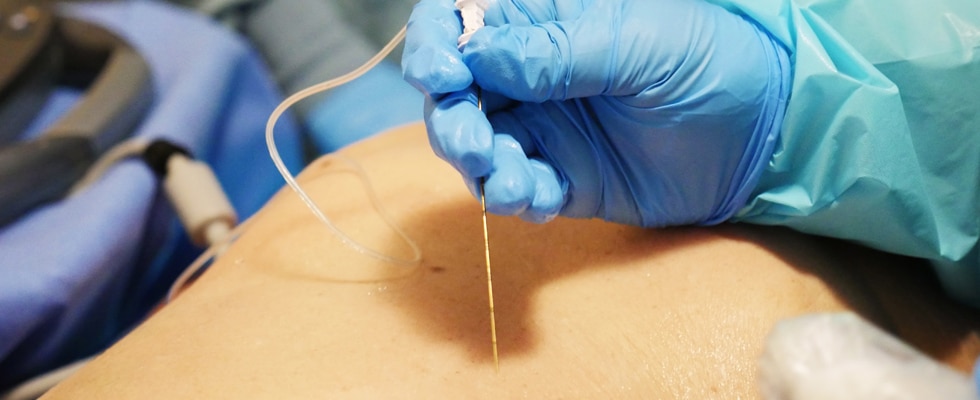
With a number of courses, ranging from pain management to point of care ultrasound, our Maverick Medical Education team gets questions about the skills and techniques our students will walk away with. In addition to the knowledge we give in each of our courses, we provide students with the opportunity for hands-on training and in person guidance from our skilled Maverick Instructors. Our Regional Anesthesia Essentials and Advanced courses train on a number of nerve blocks to provide experience in providing pain relief.
Regional Anesthesia – Essentials
- Interscalene – the interscalene block provides pain relief for the upper arm and shoulder. This block is frequently used in patients who need rotator cuff repair, have humerus fractures, or need tendon repair in the area. This block targets the brachial plexus and ultrasound assistance can help ensure the block is properly placed.
- Supraclavicular – this block also targets a similar area, allowing for treatment and care of the shoulder and arm. The supraclavicular block is very popular in cases of upper limb and shoulder surgeries.
- Axillary – the axillary block is also administered to the brachial plexus in cases of elbow, forearm, or hand surgery. This block is more distal than other blocks in a similar area which helps in cases where the upper parts of the brachial plexus is difficult.
- Adductor Canal – this is a branch of the femoral nerve and is used for pain management in the knee, lower leg, and ankle, without impacting the quadriceps. The adductor canal block is particularly useful for drainage, surgeries, and for postoperative care.
- Femoral – this block will provide pain relief for the anterior thigh, the knee, and the femur. The femoral block is a fairly easy block that sees a high rate of success and use in the medical field and is greatly used for orthopedic injuries.
- Popliteal Sciatic – for injuries or procedures below the knee, this block is ideal, particularly for ankle and distal fractures to the tibia or the fibula. The popliteal sciatic block works well for fracture reduction, drainage procedures, or for pain control as needed.
- PENG/LFCN – the pericapsular nerve group block and lateral femoral cutaneous nerve block provide pain relief for hip surgery, hip fractures, and proximal femur fractures. This technique immobilizes the hip joint without causing any muscle weakness.
Regional Anesthesia – Advanced
- Erector Spinae – this group of muscles run along the spine from the skull to the pelvis. The erector spinae block can be efficient in patients needing pain relief in a number of locations in the chest and abdominal area, like surgery on the lungs or in cases of rib fractures needing to heal.
- Paravertebral – this block is relatively easy to perform once techniques are learned and targets the area where the spinal nerves emerge from the intervertebral foramina. The paravertebral block is used during operative and post-operative care. It can also be used for acute and chronic pain relief.
- PECs 1 and 2 – in cases of anterior chest wall issues, like breast surgery, a PEC nerve block is used in the pectoral or intercostal nerves.
- Quadratus Lumborum – for patients needing abdominal surgery or procedures, the quadratus lumborum block is useful. By targeting the intercostal nerves between T6-T9, anesthesia helps block pain.
- Suprascapular – the suprascapular block is often used for chronic pain or arthritis in the shoulder, allowing patients to resume normal activity. By injecting close to the axillary nerve, pain relief from surgery or injury is possible in this area.
- TAP – this abdominal nerve block typically targets a specific area called the triangle of Petit. With ultrasound guidance, the TAP block can focus a little closer to where pain relief is needed within those abdominal walls.
- PENG/LFCN – the pericapsular nerve group block and lateral femoral cutaneous nerve block provide pain relief for hip surgery, hip fractures, and proximal femur fractures. This technique immobilizes the hip joint without causing any muscle weakness.
In our flipped model courses, you will have access to videos and written content to begin learning more about each of these blocks and how to perform them immediately, from any internet connected device. As you have time, you will be able to learn from our Maverick instructors, preparing for in person class time. Once you join the Maverick team for your instruction time, armed with the knowledge you gained in the course, you will begin to practice, getting repetition and guidance to perfect your technique. Walking away with the knowledge and experience will lead to better care and better prognosis for your patients, immediately.
To learn more about our regional anesthesia courses, or any of the other courses we offer, see our course catalog. Our Maverick Medical Education team can make you a better medical provider and provide you with the education you need for your patients.

